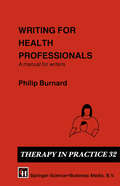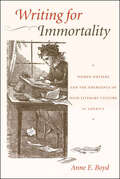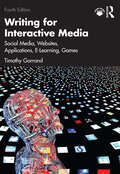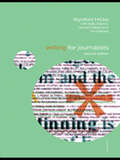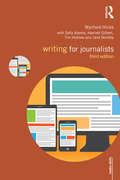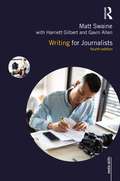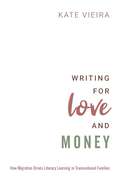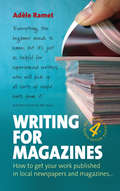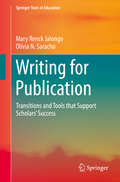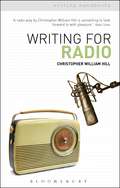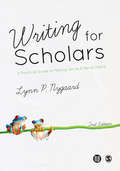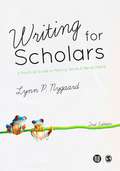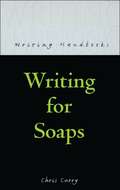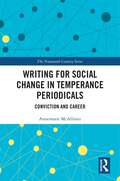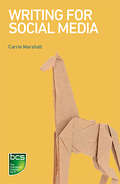- Table View
- List View
Writing for Health Professionals: A Manual for Writers (Therapy in Practice Series)
by Philip BurnardI try to leave out the parts that people skip. Elmore Leonard This book is all about writing: it is both a practical and a personal account. When you write a book like this you put yourself on the line: you run the risk of people reading what you have written and saying 'he's saying one thing and doing another'. You stand to break the rules that you set up - quite badly. That is probably not such a terrible thing; besides, that should be part of the process of using this book. As you read it, notice when rules are broken. Check the phrasing, the sentence and paragraph construction, and see whether or not I have stuck to the rules. Then see whether or not the rules would have improved the passage in question. Begin to read books as much for their style, layout and general format as for their con tent. If you are going to write, you need to see plenty of examples of all of these things - good, bad and indifferent. to write for some time but was always This is a book I have wanted nervous of writing, so here it is: an introduction to some of the ways and means of writing. lt is, as I say, personal; I hope it will be useful. A word about sexism and the writing process. I find the use of 'his or her' and its variants clumsy.
Writing for Immortality: Women and the Emergence of High Literary Culture in America
by Anne E. BoydBefore the Civil War, American writers such as Catharine Maria Sedgwick and Harriet Beecher Stowe had established authorship as a respectable profession for women. But though they had written some of the most popular and influential novels of the century, they accepted the taboo against female writers, regarding themselves as educators and businesswomen. During and after the Civil War, some women writers began to challenge this view, seeing themselves as artists writing for themselves and for posterity.Writing for Immortality studies the lives and works of four prominent members of the first generation of American women who strived for recognition as serious literary artists: Louisa May Alcott, Elizabeth Stuart Phelps, Elizabeth Stoddard, and Constance Fenimore Woolson. Combining literary criticism and cultural history, Anne E. Boyd examines how these authors negotiated the masculine connotation of "artist," imagining a space for themselves in the literary pantheon. Redrawing the boundaries between male and female literary spheres, and between American and British literary traditions, Boyd shows how these writers rejected the didacticism of the previous generation of women writers and instead drew their inspiration from the most prominent "literary" writers of their day: Emerson, James, Barrett Browning, and Eliot.Placing the works and experiences of Alcott, Phelps, Stoddard, and Woolson within contemporary discussions about "genius" and the "American artist," Boyd reaches a sobering conclusion. Although these women were encouraged by the democratic ideals implicit in such concepts, they were equally discouraged by lingering prejudices about their applicability to women.
Writing for Interactive Media: Social Media, Websites, Applications, e-Learning, Games
by Timothy GarrandThis thoroughly revised fourth edition teaches students and professionals how to create interactive content for all types of new media and become successful writers or designers in a variety of fields.This comprehensive guide is grounded in the core principles and skills of interactive media writing, in which writers create text and structure content to guide users through interactive products such as websites or software. The book examines case studies on interactive formats including complex informational websites, computer games, e-learning courses, training programs, and immersive exhibits. These case studies assess real-world products and documentation used by professional writers such as scripts, outlines, screenshots, and flowcharts. The book also provides practical advice on how to use interactive media writing skills to advance careers in the social media, technical, instructional communication, and creative media fields. This edition includes new chapters on UX Writing and Content Design, Social Media Writing, and Writing for Mobile.Writing for Interactive Media prepares students for the writing challenges of today’s technology and media. It can be used as a core textbook for courses in UX Writing, Writing for Digital Media, and Technical and Professional Communication and is a valuable resource for writing professionals at all levels.Supplemental resources include a sample syllabus, class assignments, student exercises, scripts, outlines, flowcharts, and other interactive writing samples. They are available online at www.routledge.com/9781032554242
Writing for Interactive Media: Social Media, Websites, Applications, e-Learning, Games
by Timothy GarrandThis thoroughly revised fourth edition teaches students and professionals how to create interactive content for all types of new media and become successful writers or designers in a variety of fields.This comprehensive guide is grounded in the core principles and skills of interactive media writing, in which writers create text and structure content to guide users through interactive products such as websites or software. The book examines case studies on interactive formats including complex informational websites, computer games, e-learning courses, training programs, and immersive exhibits. These case studies assess real-world products and documentation used by professional writers such as scripts, outlines, screenshots, and flowcharts. The book also provides practical advice on how to use interactive media writing skills to advance careers in the social media, technical, instructional communication, and creative media fields. This edition includes new chapters on UX Writing and Content Design, Social Media Writing, and Writing for Mobile.Writing for Interactive Media prepares students for the writing challenges of today’s technology and media. It can be used as a core textbook for courses in UX Writing, Writing for Digital Media, and Technical and Professional Communication and is a valuable resource for writing professionals at all levels.Supplemental resources include a sample syllabus, class assignments, student exercises, scripts, outlines, flowcharts, and other interactive writing samples. They are available online at www.routledge.com/9781032554242
Writing for Journalists (Media Skills)
by Wynford Hicks Sally Adams Harriett Gilbert Tim HolmesPraise for the first edition: 'There are books that are badly written, books that are well written and books that you wish you'd written. This is one of the latter. Hicks and his co-writers produce a book that is a joy to read and is packed full of helpful advice.' – Chris Frost, Journalist 'You don't have to be a journalist to read this book. Anyone with an interest in improving their writing skills and developing a sense of good style will find it useful Wynford Hicks takes a no-nonsense, sleeves rolled up approach to writing which has no time for preciousness.' – Roy Johnson, Mantex'Writing for Journalists neatly fills a gap in the market for a no-nonsense book for trainees written by trainers who genuinely understand the industry and who have moved with the times.' – Sharon Wheeler, Journalism Studies Writing for Journalists is about the craft of journalistic writing: how to put one word after another so that the reader gets the message – or the joke – goes on reading and comes back for more. It is a practical guide for all those who write for newspapers, periodicals and websites, whether students, trainees or professionals. This revised and updated edition introduces the reader to the essentials of good writing. Based on critical analysis of news stories, features and reviews from daily and weekly papers, consumer magazines, specialist trade journals and a variety of websites, Writing for Journalists includes: advice on how to start writing and how to improve and develop your style how to write a news story which is informative, concise and readable tips on feature writing from researching profiles to writing product round-ups how to structure and write reviews a new chapter on writing online copy.
Writing for Journalists (Media Skills)
by Wynford Hicks Adams Sally Harriett Gilbert Tim Holmes Jane BentleyThe new edition of Writing for Journalists focuses on the key issue for writers working across all forms of media today: how to produce clear, engaging and illuminating copy that will keep the reader hooked from start to finish. Written by skilled specialist contributors and drawing on a broad range of examples to illustrate the best professional practice, this edition includes: chapters on how to write news, features and reviews whatever the format used for delivery expanded chapters on writing for digital publication in both shortform and longform top tips on writing columns and blogs from leading professionals an exploration of the importance of style and its impact on great journalistic writing an extensive glossary of terms used in journalism and suggestions for further reading This is an essential guide to good writing for all practising journalists and students of journalism.
Writing for Journalists (Media Skills)
by Wynford Hicks Adams Sally Harriett Gilbert Tim Holmes Jane BentleyThe new edition of Writing for Journalists focuses on the key issue for writers working across all forms of media today: how to produce clear, engaging and illuminating copy that will keep the reader hooked from start to finish. Written by skilled specialist contributors and drawing on a broad range of examples to illustrate the best professional practice, this edition includes: chapters on how to write news, features and reviews whatever the format used for delivery expanded chapters on writing for digital publication in both shortform and longform top tips on writing columns and blogs from leading professionals an exploration of the importance of style and its impact on great journalistic writing an extensive glossary of terms used in journalism and suggestions for further reading This is an essential guide to good writing for all practising journalists and students of journalism.
Writing for Journalists (Media Skills)
by Matt Swaine Harriett Gilbert Gavin AllenThoroughly revised and updated, the fourth edition of Writing for Journalists focuses on the craft of journalistic writing, offering invaluable insight on how to hook readers and keep them to the end of your article. The book offers a systematic approach to news and feature writing that starts with the basics and builds to more complex and longer pieces. The authors give the reader the tools they need to deliver engaging and authoritative writing that works across print and digital. Drawing on professional insight from writers across the industry, the book guides readers through the essential elements needed to write powerful and effective news stories, from hard news pieces to features on business, science, travel and entertainment reviews. New to this edition are hands-on writing exercises accompanying each chapter to help reinforce key points; chapters on how to build a professional profile, pitch stories and get commissioned; and a section on online writing, SEO, analytics and writing for social media. This is an essential guide for all journalism students and early-career journalists. It also has much to offer established journalists looking to develop their writing and lead editorial teams.
Writing for Journalists (Media Skills)
by Matt Swaine Harriett Gilbert Gavin AllenThoroughly revised and updated, the fourth edition of Writing for Journalists focuses on the craft of journalistic writing, offering invaluable insight on how to hook readers and keep them to the end of your article. The book offers a systematic approach to news and feature writing that starts with the basics and builds to more complex and longer pieces. The authors give the reader the tools they need to deliver engaging and authoritative writing that works across print and digital. Drawing on professional insight from writers across the industry, the book guides readers through the essential elements needed to write powerful and effective news stories, from hard news pieces to features on business, science, travel and entertainment reviews. New to this edition are hands-on writing exercises accompanying each chapter to help reinforce key points; chapters on how to build a professional profile, pitch stories and get commissioned; and a section on online writing, SEO, analytics and writing for social media. This is an essential guide for all journalism students and early-career journalists. It also has much to offer established journalists looking to develop their writing and lead editorial teams.
Writing for Love and Money: How Migration Drives Literacy Learning in Transnational Families
by Kate VieiraThis book tells the story of how families separated across borders write--and learn new ways of writing--in pursuit of love and money. According to the UN, 244 million people currently live outside their countries of birth. The human drama behind these numbers is that parents are often separated from children, brothers from sisters, lovers from each other. Migration, undertaken in response to problems of the wallet, also poses problems for the heart. Writing for Love and Money shows how families separated across borders turn to writing to address these problems. Based on research with transnational families in Latin America, Eastern Europe, and North America, it describes how people write to sustain meaningful relationships across distance and to better their often impoverished circumstances. Despite policy makers' concerns about "brain drain," the book reveals that immigrants' departures do not leave homelands wholly educationally hobbled. Instead, migration promotes experiences of literacy learning in transnational families as they write to reach the two life goals that globalization consistently threatens: economic solvency and familial intimacy.
WRITING FOR LOVE & MONEY C: How Migration Drives Literacy Learning in Transnational Families
by Kate VieiraThis book tells the story of how families separated across borders write--and learn new ways of writing--in pursuit of love and money. According to the UN, 244 million people currently live outside their countries of birth. The human drama behind these numbers is that parents are often separated from children, brothers from sisters, lovers from each other. Migration, undertaken in response to problems of the wallet, also poses problems for the heart. Writing for Love and Money shows how families separated across borders turn to writing to address these problems. Based on research with transnational families in Latin America, Eastern Europe, and North America, it describes how people write to sustain meaningful relationships across distance and to better their often impoverished circumstances. Despite policy makers' concerns about "brain drain," the book reveals that immigrants' departures do not leave homelands wholly educationally hobbled. Instead, migration promotes experiences of literacy learning in transnational families as they write to reach the two life goals that globalization consistently threatens: economic solvency and familial intimacy.
Writing For Magazines (4th Edition): How to get your work published in local newspapers and magazines
by Adèle RametWritten by an experienced author, this practical book shows you how to produce manuscripts to fit a specific slot, advises you on how to adapt your style to suit different markets, and how to utilise research material to write facts and fiction effectively.Contents: 1. Mixing fact and fiction; 2. Constructing an article; 3. Getting articles into print; 4. Researching and filing systems; 5. Rewriting for different markets; 6. Writing short stories; 7. Caring for your characters; 8. Finding the right format; 9. Creating a Twist in the Tale; 10. Signposting; 11. Twisting With Little Old Ladies; 12. Fitting a Specific Plot; 13. Working as a Freelance; 14. Marketing Your Manuscript; 15. Keeping Records; Solutions to exercises; Glossary; Useful addresses; Further reading; Index.
Writing for Publication: Transitions and Tools that Support Scholars’ Success (Springer Texts in Education)
by Mary Renck Jalongo Olivia N. SarachoThis book offers systematic instruction and evidence-based guidance to academic authors. It demystifies scholarly writing and helps build both confidence and skill in aspiring and experienced authors. The first part of the book focuses on the author’s role, writing’s risks and rewards, practical strategies for improving writing, and ethical issues. Part Two focuses on the most common writing tasks: conference proposals, practical articles, research articles, and books. Each chapter is replete with specific examples, templates to generate a first draft, and checklists or rubrics for self-evaluation. The final section of the book counsels graduate students and professors on selecting the most promising projects; generating multiple related, yet distinctive, publications from the same body of work; and using writing as a tool for professional development. Written by a team that represents outstanding teaching, award-winning writing, and extensive editorial experience, the book leads teacher/scholar/authors to replace the old “publish or perish” dictum with a different, growth-seeking orientation: publish and flourish.
Writing for Radio (Writing Handbooks)
by Christopher William HillWriting for Radio is an entertaining, accessible and informative book, providing a step-by-step guide to writing for this specific dramatic medium. A helpful approach to the process of writing a successful radio play from first draft to production draft and on into the recording studio, this book is suitable for first time writers, as well as established writers who simply haven't yet written for radio. A practical handbook that's both reliable and upbeat, providing an honest 'insider's view' of how radio plays are written and recorded.
Writing for Radio (Writing Handbooks #47)
by Christopher William HillWriting for Radio is an entertaining, accessible and informative book, providing a step-by-step guide to writing for this specific dramatic medium. A helpful approach to the process of writing a successful radio play from first draft to production draft and on into the recording studio, this book is suitable for first time writers, as well as established writers who simply haven't yet written for radio. A practical handbook that's both reliable and upbeat, providing an honest 'insider's view' of how radio plays are written and recorded.
Writing for Scholars: A Practical Guide to Making Sense & Being Heard
by Lynn NygaardLecturers request your electronic inspection copy here. Academics are not just researchers, but writers too. Using her many years of practical experience gained as a teacher and editor, Lynn Nygaard guides you through the whole process of writing and presenting your research in order to help you make your voice heard within the academic community. Grounded in real world advice rather than abstract best practice, Nygaard demonstrates a number of approaches to writing in order to help you identify those most suited to your own project. This updated new edition includes: Revised and expanded sections in each chapter More focus on the social sciences A more international focus Updated discussions on publishing practices Annotated biographies for each chapter New illustrations and images Additional practical tips and exercises From defining your audience, to forming your argument and structuring your work, this book will enable you to communicate your research passionately and professionally. Lynn Nygaard is Special Adviser on Project Development and Publications at the Peace Research Institute Oslo (PRIO). Companion Website study.sagepub.com/nygaardwritingforscholars Visit the companion website for additional online resources! This updated new edition includes: Revised and expanded sections in each chapter More focus on the social sciences A more international focus Updated discussions on publishing practices Annotated bibliographies for each chapter New illustrations and images Additional practical tips and exercises From defining your audience, to forming your argument and structuring your work, this book will enable you to communicate your research passionately and professionally.
Writing for Scholars: A Practical Guide to Making Sense & Being Heard (PDF)
by Lynn NygaardLecturers request your electronic inspection copy here. Academics are not just researchers, but writers too. Using her many years of practical experience gained as a teacher and editor, Lynn Nygaard guides you through the whole process of writing and presenting your research in order to help you make your voice heard within the academic community. Grounded in real world advice rather than abstract best practice, Nygaard demonstrates a number of approaches to writing in order to help you identify those most suited to your own project. This updated new edition includes: Revised and expanded sections in each chapter More focus on the social sciences A more international focus Updated discussions on publishing practices Annotated biographies for each chapter New illustrations and images Additional practical tips and exercises From defining your audience, to forming your argument and structuring your work, this book will enable you to communicate your research passionately and professionally. Lynn Nygaard is Special Adviser on Project Development and Publications at the Peace Research Institute Oslo (PRIO). Companion Website study.sagepub.com/nygaardwritingforscholars Visit the companion website for additional online resources! This updated new edition includes: Revised and expanded sections in each chapter More focus on the social sciences A more international focus Updated discussions on publishing practices Annotated bibliographies for each chapter New illustrations and images Additional practical tips and exercises From defining your audience, to forming your argument and structuring your work, this book will enable you to communicate your research passionately and professionally.
Writing for Scholars: A Practical Guide to Making Sense and Being Heard (2nd edition)
by Lynn P. NygaardAcademics are not just researchers, but writers too. Using her many years of practical experience gained as a teacher and editor, Lynn Nygaard guides you through the whole process of writing and presenting your research in order to help you make your voice heard within the academic community. Grounded in real world advice rather than abstract best practice, Nygaard demonstrates a number of approaches to writing in order to help you identify those most suited to your own project. This updated new edition includes: Revised and expanded sections in each chapter More focus on the social sciences A more international focus Updated discussions on publishing practices Annotated biographies for each chapter New illustrations and images Additional practical tips and exercises From defining your audience, to forming your argument and structuring your work, this book will enable you to communicate your research passionately and professionally. Lynn Nygaard is Special Adviser on Project Development and Publications at the Peace Research Institute Oslo (PRIO). Companion Website study. sagepub. com/nygaardwritingforscholars Visit the companion website for additional online resources! This updated new edition includes: Revised and expanded sections in each chapter More focus on the social sciences A more international focus Updated discussions on publishing practices Annotated bibliographies for each chapter New illustrations and images Additional practical tips and exercises From defining your audience, to forming your argument and structuring your work, this book will enable you to communicate your research passionately and professionally.
Writing for Soaps (Writing Handbooks)
by Chris CurrySoap opera has become the most popular form of radio and television drama and now constitutes the biggest market for modern day dramatists. For the new writer, as well as those experienced in other genres, this book reveals how Soap works. As well as covering the specifics of Soap writing, Chris Curry guides the writer through the uniquely collaborative process from storylining to finished script.'A clear, honest, practical and funny guide to soap writing' - Valerie Windsor.
Writing for Soaps (Writing Handbooks #49)
by Chris CurrySoap opera has become the most popular form of radio and television drama and now constitutes the biggest market for modern day dramatists. For the new writer, as well as those experienced in other genres, this book reveals how Soap works. As well as covering the specifics of Soap writing, Chris Curry guides the writer through the uniquely collaborative process from storylining to finished script.'A clear, honest, practical and funny guide to soap writing' - Valerie Windsor.
Writing for Social Change in Temperance Periodicals: Conviction and Career (The Nineteenth Century Series)
by Annemarie McAllisterThis book suggests alternative ways of looking at what made a writer, what people gained from writing, and explores the alternative world of temperance periodicals of the nineteenth and early twentieth century. It introduces some of the now-forgotten writers who, in their thousands, kept the Victorian periodical presses rolling, and the public entertained. Locating their writing in the context of their personal commitment, the study takes seven prolific writers who were outside what we now think of as the circuits of conventional publication and authorship, and looks at how they found ways to make their voices heard. Their absorption in a cause led them to forge impressive writing careers in a variety of genres and media, focusing around high-circulation temperance periodicals. Examining their cultural contributions as well as their professional lives confirms the importance of the temperance movement in the second half of the nineteenth century, and raises questions about distribution practices and values, and distinctions between ‘life’ and ‘work.’
Writing for Social Change in Temperance Periodicals: Conviction and Career (The Nineteenth Century Series)
by Annemarie McAllisterThis book suggests alternative ways of looking at what made a writer, what people gained from writing, and explores the alternative world of temperance periodicals of the nineteenth and early twentieth century. It introduces some of the now-forgotten writers who, in their thousands, kept the Victorian periodical presses rolling, and the public entertained. Locating their writing in the context of their personal commitment, the study takes seven prolific writers who were outside what we now think of as the circuits of conventional publication and authorship, and looks at how they found ways to make their voices heard. Their absorption in a cause led them to forge impressive writing careers in a variety of genres and media, focusing around high-circulation temperance periodicals. Examining their cultural contributions as well as their professional lives confirms the importance of the temperance movement in the second half of the nineteenth century, and raises questions about distribution practices and values, and distinctions between ‘life’ and ‘work.’
Writing for Social Media
by Carrie MarshallEngaging with customers through social media is essential for businesses in this day and age. Writing for social media can be difficult to get right and even big brands can get it very wrong. This book walks you through how to deliver maximum benefit for your business through your social media writing. Topics include how to develop an online persona, how to tailor your messages across different social media platforms, how to appeal to your audience, and how to use social media tools.
Writing for Social Media: Business And Technical Writing Series
by Carrie MarshallEngaging with customers through social media is essential for businesses in this day and age. Writing for social media can be difficult to get right and even big brands can get it very wrong. This book walks you through how to deliver maximum benefit for your business through your social media writing. Topics include how to develop an online persona, how to tailor your messages across different social media platforms, how to appeal to your audience, and how to use social media tools.
Writing for Social Scientists, Third Edition: How to Start and Finish Your Thesis, Book, or Article (Chicago Guides to Writing, Editing, and Publishing)
by Howard S. BeckerFor more than thirty years, Writing for Social Scientists has been a lifeboat for writers in all fields, from beginning students to published authors. It starts with a powerful reassurance: Academic writing is stressful, and even accomplished scholars like sociologist Howard S. Becker struggle with it. And it provides a clear solution: In order to learn how to write, take a deep breath and then begin writing. Revise. Repeat. This is not a book about sociological writing. Instead, Becker applies his sociologist’s eye to some of the common problems all academic writers face, including trying to get it right the first time, failing, and therefore not writing at all; getting caught up in the trappings of “proper” academic writing; writing to impress rather than communicate with readers; and struggling with the when and how of citations. He then offers concrete advice, based on his own experiences and those of his students and colleagues, for overcoming these obstacles and gaining confidence as a writer. While the underlying challenges of writing have remained the same since the book first appeared, the context in which academic writers work has changed dramatically, thanks to rapid changes in technology and ever greater institutional pressures. This new edition has been updated throughout to reflect these changes, offering a new generation of scholars and students encouragement to write about society or any other scholarly topic clearly and persuasively. As Becker writes in the new preface, “Nothing prepared me for the steady stream of mail from readers who found the book helpful. Not just helpful. Several told me the book had saved their lives; less a testimony to the book as therapy than a reflection of the seriousness of the trouble writing failure could get people into.” As academics are being called on to write more often, in more formats, the experienced, rational advice in Writing for Social Scientists will be an important resource for any writer’s shelf.
